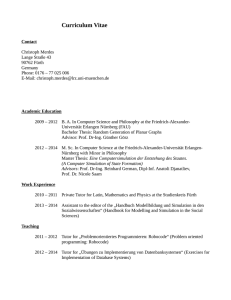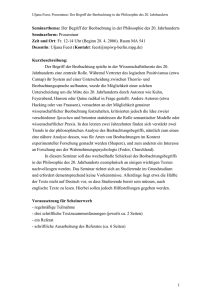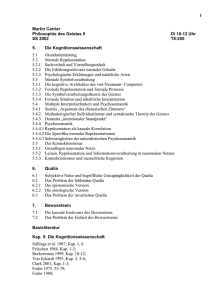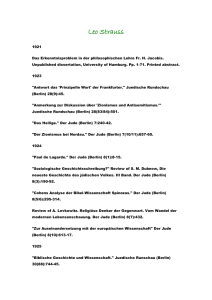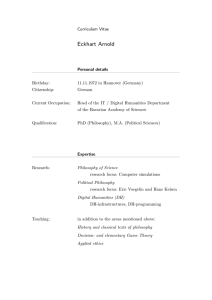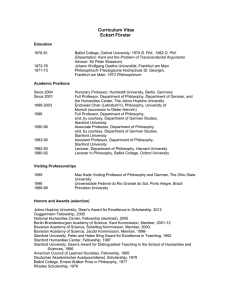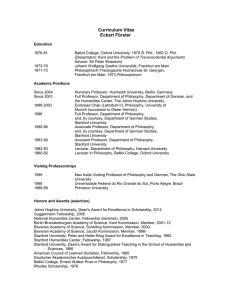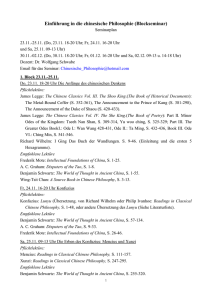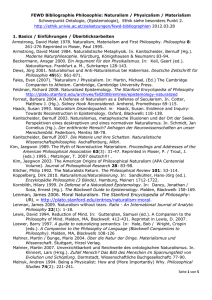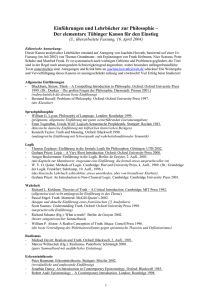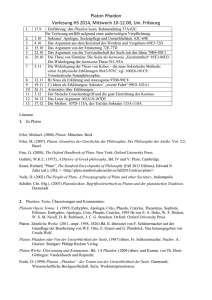Literatur
Werbung
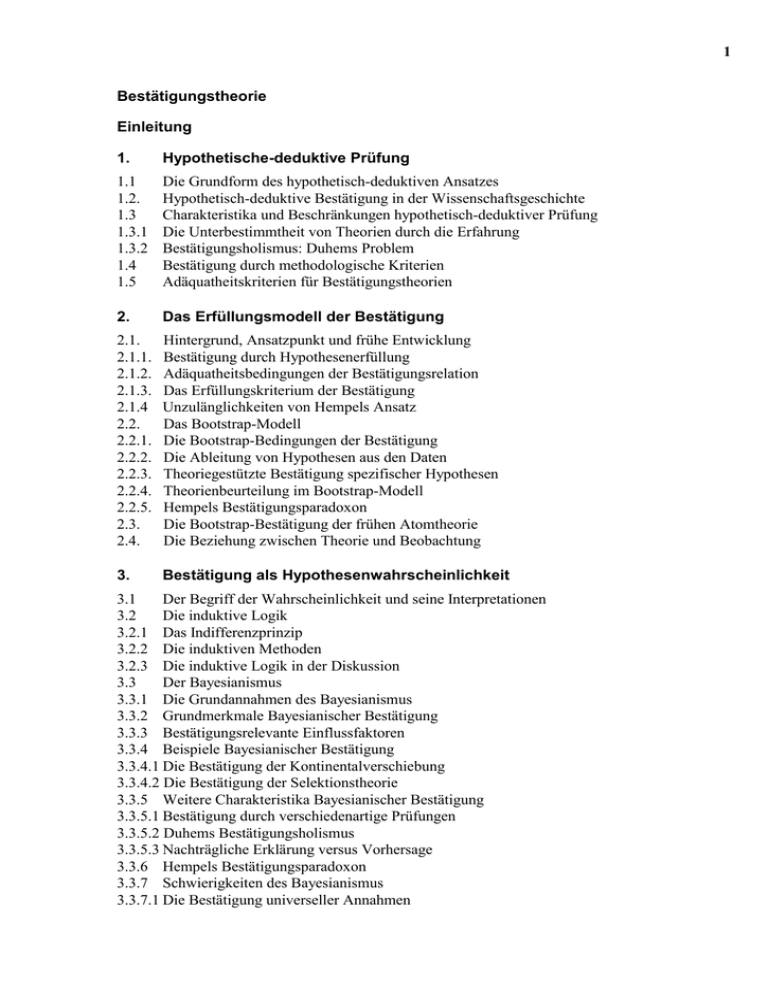
1 Bestätigungstheorie Einleitung 1. Hypothetische-deduktive Prüfung 1.1 1.2. 1.3 1.3.1 1.3.2 1.4 1.5 Die Grundform des hypothetisch-deduktiven Ansatzes Hypothetisch-deduktive Bestätigung in der Wissenschaftsgeschichte Charakteristika und Beschränkungen hypothetisch-deduktiver Prüfung Die Unterbestimmtheit von Theorien durch die Erfahrung Bestätigungsholismus: Duhems Problem Bestätigung durch methodologische Kriterien Adäquatheitskriterien für Bestätigungstheorien 2. Das Erfüllungsmodell der Bestätigung 2.1. 2.1.1. 2.1.2. 2.1.3. 2.1.4 2.2. 2.2.1. 2.2.2. 2.2.3. 2.2.4. 2.2.5. 2.3. 2.4. Hintergrund, Ansatzpunkt und frühe Entwicklung Bestätigung durch Hypothesenerfüllung Adäquatheitsbedingungen der Bestätigungsrelation Das Erfüllungskriterium der Bestätigung Unzulänglichkeiten von Hempels Ansatz Das Bootstrap-Modell Die Bootstrap-Bedingungen der Bestätigung Die Ableitung von Hypothesen aus den Daten Theoriegestützte Bestätigung spezifischer Hypothesen Theorienbeurteilung im Bootstrap-Modell Hempels Bestätigungsparadoxon Die Bootstrap-Bestätigung der frühen Atomtheorie Die Beziehung zwischen Theorie und Beobachtung 3. Bestätigung als Hypothesenwahrscheinlichkeit 3.1 Der Begriff der Wahrscheinlichkeit und seine Interpretationen 3.2 Die induktive Logik 3.2.1 Das Indifferenzprinzip 3.2.2 Die induktiven Methoden 3.2.3 Die induktive Logik in der Diskussion 3.3 Der Bayesianismus 3.3.1 Die Grundannahmen des Bayesianismus 3.3.2 Grundmerkmale Bayesianischer Bestätigung 3.3.3 Bestätigungsrelevante Einflussfaktoren 3.3.4 Beispiele Bayesianischer Bestätigung 3.3.4.1 Die Bestätigung der Kontinentalverschiebung 3.3.4.2 Die Bestätigung der Selektionstheorie 3.3.5 Weitere Charakteristika Bayesianischer Bestätigung 3.3.5.1 Bestätigung durch verschiedenartige Prüfungen 3.3.5.2 Duhems Bestätigungsholismus 3.3.5.3 Nachträgliche Erklärung versus Vorhersage 3.3.6 Hempels Bestätigungsparadoxon 3.3.7 Schwierigkeiten des Bayesianismus 3.3.7.1 Die Bestätigung universeller Annahmen 2 3.3.7.2 Die Bestätigung durch bekannte Daten 3.3.7.3 Die Bestimmung der Anfangswahrscheinlichkeiten 3.3.8 Subjektivismus vs. Objektivismus 4. Der irrtumsstatistische Ansatz 4.1 4.1.1 4.1.2 4.2 4.3 4.4 Grundlagen und Charakteristika Hypothesenprüfung in der statistischen Testtheorie Aus Fehlern lernen Der Anschluss an den Neuen Experimentalismus Wider Unterbestimmtheit und Bestätigungsholismus Die Beschaffenheit lokaler Prüfungen Basisliteratur Einführung Lambert & Brittan 1987, 67-110. Earman & Salmon 1992. Kap. 1: Hypothetisch-deduktive Prüfung Hempel 1966, Kap. 1-3; Duhem 1906, 217-253; Kosso 1992, 27-50, 69-91; Salmon 1973, 214-229; Earman & Salmon 1992, 43-49; Kuhn 1977. Kap. 2: Das Erfüllungsmodell der Bestätigung 2.1 Hempel Hempel 1945; Earman & Salmon 1992, 49-55. 2.2 Glymour Glymour 1980, 16-39, 110-263; Lambert & Brittan 1987, 75-87, 99-109; Gardner 1979; Carrier 1994, 52-70; Carrier 2000. Kap. 3: Bestätigung als Hypothesenwahrscheinlichkeit 3.1 Wahrscheinlichkeit Carnap 1950; Earman & Salmon 1992, 68-84; Howson & Urbach, Chap. 2. 3.2 Induktive Logik Carnap 1955; Carnap 1953; 3 Earman & Salmon 1992, 85-89. Gower 1997, Chap. 11. 3.3 Bayesianismus Lambert & Brittan 1987, 87-99; Howson 1997a; Earman & Salmon 1992, 74-100; Howson & Urbach 1989, 13-27, 39-63, 79-118, 257-295; Glymour 1980, Chap. 3; Salmon 1967, 56-96, 115-132; Salmon 1990; Worrall 1993; Mayo 1997a. Kap. 4: Der irrtumsstatistische Ansatz Mayo 1996; Mayo 1997a; Howson 1997a; Carrier 2001. Literatur Y. Balashov (1994) „Duhem, Quine, and the Multiplicity of Scientific Tests“, Philosophy of Science 61 (1994), 608-628. R. Carnap (1950) Logical Foundations of Probability, Chicago: University of Chicago Press, 1950, Kap. II: The Two Concepts of Probability, 19-51. R. Carnap (1953) „Induktive Logik und Wissenschaft“, in: Krüger (1970), 205-212. R. Carnap (1955) „Statistische und induktive Wahrscheinlichkeit“, in: Krüger (1970), 193-204. M. Carrier (1994) The Completeness of Scientific Theories. On the Derivation of Empirical Indicators Within a Theoretical Framework: The Case of Physical Geometry, Dordrecht: Kluwer, 1994. M. Carrier (2000) „Empirische Hypothesenprüfung ohne Felsengrund, oder: Über die Fähigkeit, sich am eigenen Schopf aus dem Sumpf zu ziehen“, in: F. Stadler (ed.), Elemente moderner Wissenschaftstheorie. Zur Interaktion von Philosophie, Geschichte und Theorie der Wissenschaften, Wien: Springer, 43-56. M. Carrier (2001) “Critical Notice: Deborah G. Mayo, Error and the Growth of Experimental Knowledge”, International Studies in the Philosophy of Science 15, 93-98. D. Christensen (1992) „Confirmational Holism and the Problem of Asymmetry“, Philosophy of Science 59 (1992), 540-557. 4 M. Culler (1995) „Beyond Bootstrapping: A New Account of Evidential Relevance“, Philosophy of Science 62 (1995), 561-579. J. Dorling (1979) „Bayesian Personalism, the Methodology of Scientific Research Programmes, and Duhem’s Problem“, Studies in History and Philosophy of Science 10, 177-187. P. Duhem (1906) Ziel und Struktur der physikalischen Theorien, Hamburg: Meiner, 1978. J. Earman (ed.) (1983) Testing Scientific Theories, Minneapolis: University of Minnesota Press, 1983. J. Earman (1992) Bayes or Bust? A Critical Examination of Bayesian Confirmation Theory, Cambridge Mass.: MIT Press, 1992. J. Earman & W.C. Salmon (1992) „The Confirmation of Scientific Hypotheses“, in: M.H. Salmon (ed.), Introduction to the Philosophy of Science, Englewood Cliffs N.J.: Prentice Hall, 1992, 42-103. B. de Finetti (1972) Probability, Induction and Statistics. The Art of Guessing, New York: Wiley, 1972. A. Franklin & C. Howson (1985) „Newton and Kepler, A Bayesian Approach“, Studies in History and Philosophy of Science 16 (1985), 379-385. M.R. Gardner (1979) „Realism and Instrumentalism in 19th-Century Atomism“, Philosophy of Science 46 (1979), 1-46. C. Glymour (1980) Theory and Evidence, Princeton: Princeton University Press, 1980. B. Gower (1997) Scientific Method. An Historical and Philosophical Introduction, London: Routledge. R.E. Grandy (1967) „Some Comments on Confirmation and Selective Confirmation“, Philosophical Studies 18 (1967), 19-24. G. Hellman (1997) „Bayes and Beyond“, Philosophy of Science 64, 191-221. C.G. Hempel (1945) „Studies in the Logic of Confirmation/Postscript 1964“, in: ders., Aspects of Scientific Explanation and Other Essays in the Philosophy of Science, New York: Free Press, London: Collier-Macmillan, 1965, 3-51. C.G. Hempel (1966) Philosophie der Naturwissenschaften, München: dtv, 1974. 5 G. Hon (1998) „Essay Review: Exploiting Errors,” Studies in History and Philosophy of Science 29, 465479. C. Howson & P. Urbach (1989) Scientific Reasoning: The Baysesian Approach, La Salle Ill.: Open Court, 1989. C. Howson (1997a) “A Logic of Induction”, Philosophy of Science 64, 268-290. C. Howson (1997b) “Error Probabilities in Error”, Philosophy of Science 64 (Proceedings), S185-S194. P. Kosso (1992) Reading the Book of Nature. An Introduction to the Philosophy of Science, Cambridge: Cambridge University Press, 1992. T.S. Kuhn (1957) Die kopernikanische Revolution, Braunschweig: Vieweg, 1981. T.S. Kuhn (1977) „Objektivität, Werturteil und Theoriewahl“, in: Kuhn, Die Entstehung des Neuen. Studien zur Struktur der Wissenschaftsgeschichte, ed. L. Krüger, Frankfurt: Suhrkamp, 1978, 421445. L. Krüger (ed.) (1970) Erkentnisprobleme der Naturwissenschaften. Texte zur Einführung in die Philosophie der Wissenschaft, Köln: Kiepenheuer & Witsch, 1970. K. Lambert & G.G. Brittan (1987) An Introduction to the Philosophy of Science, Atascadero Calif.: Ridgeview, 1987. P.S. de Laplace (1814) Essai philosophique sur les probabilités, Paris : Courcier, 1814. L. Laudan (1984) Science and Values. The Aims of Science and their Role in Scientific Debate, Berkeley: University of California Press. A.L. Lavoisier (1774/1777) « Mémoire sur la calcination de l’étain dans les vaisseaux fermés et sur la cause de l’augmentation du poids qu’aquiert ce métal pendant cette opération », in : Œuvres II, 105-121. A.L. Lavoisier (1783) « Mémoire dans lequel on a pour objet de prouver que l’eau n’est point une substance simple, un élément proprement dit, mais qu’elle est susceptible de décomposition et de recomposition », in : Œuvres II, 334-359. A.L. Lavoisier (Œuvres) Œuvres de Lavoisier, I–VI, ed. J.B. Dumas & E. Grimaux, Paris : Imprimerie impériale et Imprimerie nationale, 1862–1893. P. Le Morvan (1999) “The Converse Consequence Condition and Hempelian Qualitative Confirmation”, Philosophy of Science 66, 448-454. 6 P. Maher (1999) „Inductive Logic and the Ravens Paradox“, Philosophy of Science 66, 50-70. D.G. Mayo (1994) “The New Experimentalism, Topical Hypotheses, and Learning from Error,” in: D. Hull, M. Forbes & R. Burian (eds.), PSA 1994 I, East Lansing Mich.: PSA, 270-279. D.G. Mayo (1996) Error and the Growth of ExperimentalKnowledge, Chicago: University of Chicago Press. D.G. Mayo (1997a) “Duhem’s Problem, the Bayesian Way, and Error Statistics, or ‘What’s Belief Got to Do with It?’,” Philosophy of Science 64, 222-244. D.G. Mayo (1997b) “Experimental Practice and an Error Statistical Account of Evidence”, Philosophy of Science 67 (Proceedings), S193-S207. J.B. Meusnier & A.L. Lavoisier (1784) « Mémoire où l’on prouve, par la décomposition de l’eau, que ce fluide n’est point une substance simple, et qu’il y a plusieurs moyens d’obtenir en grand l’air inflammable qui y entre comme principe constituant », in : Œuvres II, 360-373. R. v. Mises (1919) „Grundlagen der Wahrscheinlichkeitsrechnung“, Mathematische Zeitschrift 5 (1919), 5299. R. v. Mises (1928) Wahrscheinlichkeit, Statistik und Wahrheit, Berlin: Springer, 1928. S. Mitchell (1995) „Toward a Defensible Bootstrapping“, Philosophy of Science 62 (1995), 241-260. A. Musgrave (1974) „Logical versus Historical Theories of Confirmation“, British Journal for the Philosophy of Science 25 (1974), 1-23. R.E. Neapolitan (1992) „A Limiting Frequency Approach to Probability Based on the Weak Law of Large Numbers“, Philosophy of Science 59 (1992), 389-407. J. D. Norton (1993) „The Determination of Theory by Evidence: The Case for Quantum Discontinuity, 19001915“, Synthese 97 (1993), 1-31. K.R. Popper (1935) Logik der Forschung, Tübingen: Mohr, 61976. W.V. Quine & J.S. Ullian (1970) The Web of Belief, New York: Random House, 21978. H. Reichenbach (1938) Experience and Prediction. An Analysis of the Foundations and the Structure of Knowledge, Chicago: University of Chicago Press, 1966. 7 R.D. Rosenkrantz (1977) Inference, Method and Decision. Towards a Bayesian Philosophy of Science, Dordrecht: Reidel, 1987. W.C. Salmon (1967) The Foundations of Scientific Inference, Pittsburgh: University of Pittsburgh Press, 1967. W.C. Salmon (1970) „Bayes’s Theorem and the History of Science“, in: R. Stuewer (ed.), Historical and Philosophical Perspectives of Science, Minneapolis: University of Minnesota Press, 1970, 68-86. W.C. Salmon (1973) Logik, Stuttgart: Reclam, 1983. W.C. Salmon (1990) „Rationality and Objectivity in Science or Tom Kuhn Meets Tom Bayes“, in: C.W. Savage (ed.), Scientific Theories (Minnesota Studies in the Philosophy of Science XIV), Minneapolis: Minnesota University Press, 1990, 175-204. A. Wayne (1995) „Bayesianism and Diverse Evidence“, Philosophy of Science 62 (1995), 111-121. G. Wheeler (2000) “Error Statistics and Duhem’s Problem”, Philosophy of Science 67, 410-420. J. Worrall (1993) „Falsification, Rationality, and the Duhem Problem. Grünbaum versus Bayes“, in: J. Earman et al. (eds.), Philosophical Problems of the Internal and External Worlds. Essays on the Philosophy of Adolf Grünbaum, Pittsburgh: University of Pittsburgh Press/Konstanz: Universitätsverlag, 1993, 329-370.
